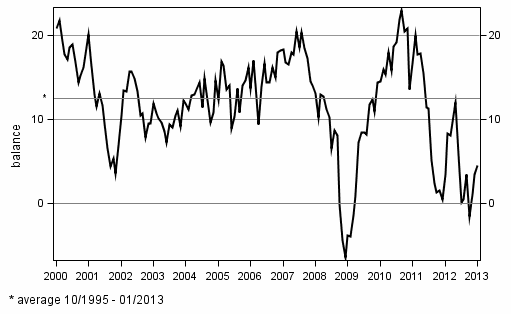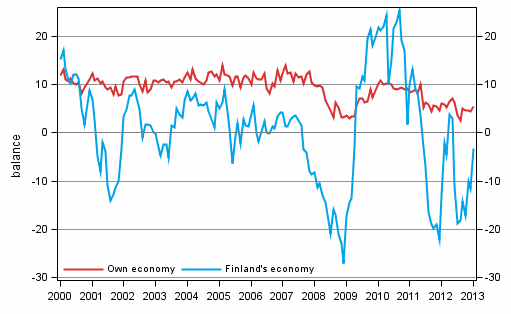Published: 28 January 2013
Consumers' confidence in the economy recovering slowly
The consumer confidence indicator stood at 4.5 in January 2013, having been 3.5 in December and 1.0 in November 2012. In January, confidence in the economy was slightly higher than one year ago (3.4), but clearly below the long-term average (12.5). The data are based on Statistics Finland’s Consumer Survey, for which 1,449 people resident in Finland were interviewed between 2 and 18 January.
Consumer confidence indicator (CCI)

Of the four components of the consumer confidence indicator expectations on own and Finland’s economy and the development of unemployment improved slightly in January from the month before. In contrast, consumers' estimates of households' saving possibilities weakened. All in all, the components of the consumer confidence indicator were in January still at a low level, except for saving possibilities.
In addition, consumers thought in January that the time was more favourable for saving than for raising a loan or buying durable goods. In January, employed consumers felt personally somewhat more threatened by unemployment than before.
Consumers' own and Finland's economy
As many as 29 per cent of consumers believed in January that Finland’s economic situation would improve in the coming twelve months, while 32 per cent of them thought that the country’s economy would deteriorate. In December, the corresponding proportions were 23 and 40 per cent and in last year's January 21 and 42 per cent.
In all, 23 per cent of consumers believed in January that their own economy would improve and 15 per cent of them feared it would worsen over the year.
Consumers' expectations concerning their own and Finland's economy in 12 months' time

Unemployment and inflation
Fourteen per cent of consumers expected in January that general unemployment would decrease in Finland over the next 12 months, while 59 per cent of them believed it would increase. In January, the respective proportions were 11 and 61 per cent.
In January, eight per cent of employed persons believed that their personal threat of unemployment had lessened over the past few months, whereas 22 per cent thought it had grown. Twelve months ago the respective proportions were 14 and 16 per cent. In January, one-half (48%) of employed persons thought the threat of unemployment had remained unchanged and one-quarter (23%) felt that they were not threatened by unemployment at all.
In January, consumers predicted that consumer prices would go up by 2.9 per cent over the next 12 months. In December, the predicted inflation rate was 3.1 per cent, and its long-term average is 2.2 per cent.
Saving and taking out a loan
As many as 58 per cent of consumers considered saving worthwhile in January. Two out of three households (66%) had been able to lay aside some money and three out of four (76%) believed they would be able to do so during the next 12 months. The latter share was 81 per cent in December. Households save mainly for the rainy day. The most popular investment targets for savings are fixed-term or investment accounts, followed by investment funds and insurances.
In January, 56 per cent of consumers regarded the time good for raising a loan. Slightly fewer households than usual, or 11 per cent of them, were planning to raise a loan within one year.
Buying of durable goods
Thirty-eight per cent of consumers considered the time favourable for buying durable goods in January. Every third consumer (33%) regarded spending money on consumption as a bad idea. Despite moderate consumption intentions, 13 per cent of households were fairly or very certain to buy a car and seven per cent a dwelling in the next twelve months. In December and one year ago, however, slightly more households, 16 per cent, were going to buy a car. In January, 21 per cent of households were planning to make renovations to their dwelling.
Consumers' views of the economy
| Average 10/1995- | Max. 10/1995- | Min. 10/1995- | 01/2012 | 12/2012 | 01/2013 | Outlook | |
| A1 Consumer confidence indicator, CCI = (B2+B4+B7+D2)/4 | 12,5 | 22,9 | -6,5 | 3,4 | 3,5 | 4,5 | -- |
| B2 Own economy in 12 months' time (balance) | 8,7 | 14,1 | 2,3 | 6,1 | 4,4 | 5,5 | -- |
| B4 Finland's economy in 12 months' time (balance) | 3,8 | 25,3 | -27,1 | -13,0 | -11,4 | -3,3 | - |
| B6 Inflation in 12 months' time (per cent) | 2,2 | 4,6 | 0,6 | 3,1 | 3,1 | 2,9 | |
| B7 Unemployment in Finland in 12 months' time (balance) | -0,7 | 27,6 | -51,1 | -23,5 | -28,1 | -25,8 | -- |
| B8 Own threat of unemployment now (balance) | 0,5 | 7,6 | -18,8 | 0,9 | -5,8 | -8,2 | -- |
| C1 Favourability of time for purchasing durables (balance) | 19,8 | 41,8 | -14,2 | 17,6 | 0,1 | 4,9 | -- |
| C2 Favourability of time for saving (balance) | 11,7 | 36,8 | -19,6 | 15,1 | 10,1 | 10,9 | +/- |
| C3 Favourability of time for raising a loan (balance) | 17,4 | 42,0 | -47,1 | 2,5 | 9,7 | 10,1 | - |
| D2 Household's saving possibilities in the next 12 months (balance) | 38,3 | 52,2 | 10,9 | 44,0 | 49,0 | 41,5 | + |
The balance figures are obtained by deducting the weighted proportion of negative answers from that of positive answers. The consumer confidence indicator is the average of the balance figures for the CCI components. The balance figures and the confidence indicator can range between -100 and +100 – the higher (positive) balance figure, the brighter the view on the economy.
Explanations for Outlook column: ++ Outlook is very good, + Outlook is good, +/- Outlook is neutral, - Outlook is poor, -- Outlook is very poor. Deviation of balance from average has been compared to standard deviation.
The population and sample of the Consumer Survey
The population of the Consumer Survey comprises 4.4 million persons aged 15 to 84 and their 2.6 million households in Finland. The population was extended to persons aged 75 to 84 starting from January 2012. The gross size of the monthly sample of the Survey is 2,350 persons (previously 2,200 persons).
In January, the non-response rate of the Survey was 38.3 per cent. The non-response rate includes those who refused from the survey or were otherwise prevented from participating as well as those who could not be contacted.
The extension of the population, that is, responses from persons aged 75 to 84, is estimated to have weakened the value of the consumer confidence indicator by good one unit starting from January 2012. This has mainly been caused by the fall in the balance figure of one component, households' saving possibilities. The extension of the population has also somewhat affected the frequency percentages of home technology in households.
EU results
The (seasonally adjusted) Consumer Survey results for all EU countries are released on the European Commission website: European Commission, DG ECFIN, Business and Consumer Survey Results; http://ec.europa.eu/economy_finance/db_indicators/surveys/index_en.htm .
Source: Consumer Survey 2013, January. Statistics Finland
Inquiries: Pertti Kangassalo 09 1734 3598, Tara Junes 09 1734 3503, kuluttaja.barometri@stat.fi
Director in charge: Riitta Harala
Publication in pdf-format (467.6 kB)
- Reviews
-
- 1. Method of the Consumer Survey (28.1.2013)
- Tables
-
Tables in databases
Pick the data you need into tables, view the data as graphs, or download the data for your use.
Appendix tables
- Figures
-
- Appendix figure 1. Consumer confidence indicator (CCI) (28.1.2013)
- Appendix figure 2. Micro and macro indicators (28.1.2013)
- Appendix figure 3. Own economy (28.1.2013)
- Appendix figure 4. Finland's economy (28.1.2013)
- Appendix figure 5. Inflation (28.1.2013)
- Appendix figure 6. Unemployment (28.1.2013)
- Appendix figure 7. Favourability of time for (28.1.2013)
- Appendix figure 8. Household's financial situation (28.1.2013)
- Appendix figure 9. Household's intentions to raise a loan, next 12 months (28.1.2013)
- Appendix figure10. Spending on durables, next 12 months vs last 12 months (28.1.2013)
- Appendix figure 11. Household's intentions to buy, next 12 months (28.1.2013)
Updated 28.1.2013
Official Statistics of Finland (OSF):
Consumer Confidence [e-publication].
ISSN=2669-8889. January 2013. Helsinki: Statistics Finland [referred: 27.12.2025].
Access method: http://stat.fi/til/kbar/2013/01/kbar_2013_01_2013-01-28_tie_001_en.html

